What have we learned so far? — Analysis
Monday, 22nd Aug 2022 17:03 by Dan Lambert Delighted to say that Dan Lambert has agreed to bring a series of his tactical analysis pieces to LFW this season, starting with this piece on the early changes and learnings from Michael Beale’s initial games in charge.
We’re now just under a month into ‘Bealeball’ since the league opener against Blackburn Rovers. Mixed results, and performances too, but within that there have been some positives and some good tactical tweaks to form the start of Beale’s identity. Nevertheless, the new manager has made it only one win from five, whilst gaining five points from a possible 15.
In this piece I have a look at the emerging patterns of play Beale has implemented so far in the first four league games.
1 - Shape, pressing and rest attack
Beale plays a quite unique system, a 4-3-2-1 and rather than with wingers he uses “roaming 10s” that play a lot more centrally. It’s a narrow shape, screening opposition sides to play out wide where they implement what’s known as pressing triggers, to create traps in wide areas where teams try to dominate. The main focus of Beale’s pragmatic off ball shape is compactness, an aim to prevent sides playing directly through central areas closer to the goal.

4-3-2-1 narrow shape. Front three high (bigger distances to midfield three), the back four compact and the midfield three expansive due to the effect on the pressing triggers.
With the narrow shape and allowing the opposition to play out wide comes the pressing triggers, particularly with the use of the wide CMs depending on which side the ball is on. There are two things to note with the triggers. Having spoken to Andre Dozzell in an interview recently, I asked him about the pressing triggers and its effect with pitch geography or generic locations and it was interesting to hear the difference with who presses the wide FB/WB of the opposition. If its ahead of the front three, the ball near ten presses, but if it's behind the front line the ball near CM presses.
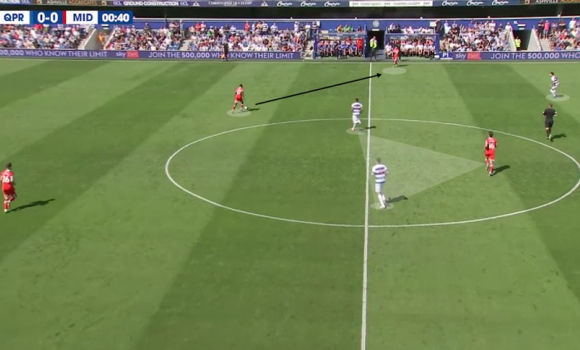
Front two of the three screen the passing lane into Howson to stifle build-up. Options are sideways and Bola plays a ball to Giles. Amos (highlighted) is ready to press as the pass is the trigger.

Giles tries to receive with an open body position but the pressure from Amos forces him backwards. Willock pushes m2m on Bola and Chair tucks inside to press Howson’s movement m2m.
Notice that between the triggers it starts with a zonal press (covers the spaces) and then turns into a man orientated press (man to man) which is a recurring theme with the wide pressing traps.

Zonal shape from the front three. The back-pass triggers a higher proactive press.

Phase two of the press. Dykes is in a ‘half position’ pressing Grimshaw whilst also acting as the cover shadow to block off a pass to Rhys Williams. Chair is pressing Ekpiteta moving m2m if the pass is on whilst Field presses Patino offering a short.

Boro 4v3 out wide but Rangers use a pressing trap effectively. Willock presses Bola and screens the option of Howson. Amos is ready to press Giles should the pass occur and Stef pushes onto McGree who shows an option.
Also note in that photo above that the front three are high and narrow preventing central areas to be open. The front three being high, leads to my point on ‘rest attack’- a structure in which the attack is set in to create attacking opportunities when regaining the ball. This is particularly important in Beale’s system as the press and narrow shape allow for turnovers. With the front three being high, it allows them to start their attacks closer to the goal, win back the ball higher and create a moment of ‘chaos’ when attacking a team who aren’t in a set shape.

Example of the rest attack. High front three- distances bigger to midfield three. Narrow shape preventing circulation in central areas and man marking the double pivot to prevent build-up.
These ideals are pretty much the basics and principles of ‘Bealeball’, with a lot of focus on the off-ball work and a more ‘fluid final third’ ahead.
2 - Defensive Rotations
Within the 4321 system we’ve seen how the “wide three” or even wide two work in tandem with each other. By wide three I mean the full back, ball near no.8 and the ball near no.10. What is interesting is a few variations of the collective three are used by rotating in defensive situations to still maintain a compact shape and by following the man orientated ‘rule’ when doing so. I’ll touch on a few situations below.

2v2 situation or 2v3 with Shodipo tracking back. Pickering hugs the touchline to draw Kakay in. Brereton Diaz (marked by Dozzell) looks to lay off to the FB to create a one two and attack the space beyond Kakay.

Dozzell tracks the run and slots into the RB role as shown by the back four shape still intact. Kakay’s pressure forces Pickering backwards, an aim of the wide pressing traps, and the backpass triggers Shodipo to press the on the ball midfielder. As shown by the triangle, they still remain in tandem.

Brereton Diaz plays the layoff. Kakay applies pressure. Diaz makes the run off Dozzell’s blindside but Dozzell is proactive and follows the run into that full back area that is left free.
We saw against Middlesborough the same idea in the defensive rotations, but a different three working in tandem.

This three in tandem are Dunne (LCB), Paal (LB) and Field (LCM). Boro in this situation are trying to create a wide overload in this instance 3v3.

Watmore drops inside to receive from Crooks. Dunne remains m2m with him as Field tracks the run of Crooks making a forward run into the space previously vacated by Watmore. Watmore looks to lay off the ball to Jones (out of picture).

Field has now taken up the LCB spot, Duncan Watmore is making an underlapping run down the channel to create space for Jones to come inside.

Dunne and Paal swap markers but still stay m2m in the wide 2v2. Again, the rotation has occurred in their positioning but the structure of the shape remains the same filling in for different positions- the three remain in tandem.
Another variation of a defensive rotation was through just the no.10 and FB working together in tandem to rotate and provide cover within the defensive shape when in individual 1v1s.

Kakay gets drawn to a 1v1 with Clarke. Space between CBs and RB area is free as is exploited by Cirkin making the underlapping run. Shodipo tracks the run.

Shodipo follows the run and settles in the RB area to form and maintain the back four shape. Kakay comes inside to defend Clarke’s movement.
Defensive rotations have proved to be an effective way of stopping opposition from creating overloads or getting joy from creating space with combination play. Mobility/athleticism in these scenarios work in order to track the man and stay m2m but also by rotating the importance of keeping the shape together works, but also the compactness of the shape just by rotating positions. But from the three variations we’ve seen so far- it’s been impressive to see the different combinations working in tandem together whilst looking relatively compact out of possession.
3 - Creating Overloads in build-up
We saw even in pre-season one of the first patterns of play under Beale was the way he created overloads in the build-up phase by dropping Johansen as the 6 both in between/outside the CBs. But Beale has showed different variations by using the wide no.8 to drop outside the CBs to form an asymmetric back three. It certainly helps beat the press by adding a +1 in build-up but Beale has shown flexibility with the way he uses the overload in different variations.

Overload created by Dozzell (RCM) dropping into the full back area to create a back 3 in build up by dropping outside the CBs. Helped to play through the Blackburn press, draw Brereton Diaz to press him and creates more space for others to move into.
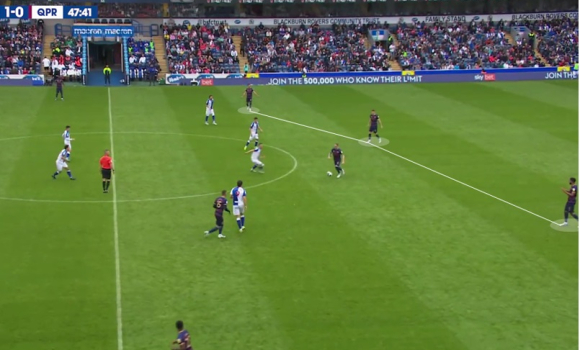
Dozzell drops outside the CBs to form a makeshift back 3 when building out, emptying the congested central space. Kakay provides Rangers with an outlet out wide with aggressive positioning high and wide. High risk reward with Dozzell as right sided cover.
But from the use of Dozzell dropping into the full back areas, it also brought some dilemmas with pushing the FBs high, tucking the CMs inside and leaving a load of space in the full back areas for opponent teams to exploit on the far side.

Dozzell moves into the empty central space to cover behind Johansen. Brereton Diaz stays high to vacate the space blindside of Dickie with Kakay gradually dropping in to cover.

Rovers are in transition. Brereton Diaz ready to anticipate the ball beyond Dickie. Dozzell and Kakay positioned too high gifting the space. Thankfully a let off as the counter attack doesn’t reach Brereton Diaz.
As well as Dozzell or the right hand sided eight depending on who is playing there, Johansen as the 6 is an easy access point (screening the back four) to drop into the backline to create overloads in build-up.
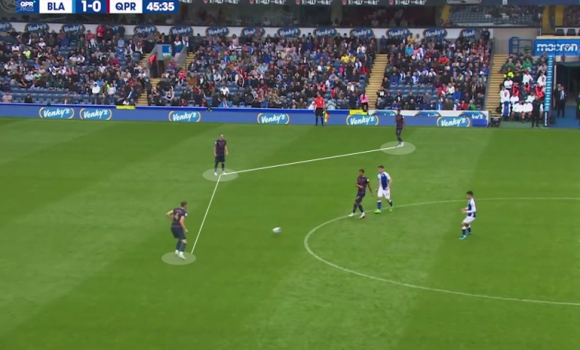
Johansen drops between the CBs to collect the ball, creating an overload in build-up giving the ‘formed back 3’ a better chance of progression.

Again, a back three formed. Sunderland in this instance go m2m on the wide CBs leaving Johansen as the spare man.

The space is there for Johansen to exploit, and rather than progressing the ball as we know him best for, he drives into the space beating the first phase of Sunderland’s press.

Another 3v2 build-up with Stef dropping in as the +1 with space in front of him.

Different outcome this time as Johansen drives slightly before progressing up the pitch from deep.
In terms of progression from build-up, we haven’t seen huge amounts unless it’s Rob Dickie driving at teams and stepping up into midfield so to see a different way to build-up using numerous midfielders, whilst pushing the full backs up to create width as a way to build is refreshing. I think, with a keen eye it will be interesting to see in any coming games if teams try to completely isolate Johansen out the game. We saw against Sunderland they did it to an extent, but not throughout the whole game.
4 - Positional overloads
From the first four league games I haven’t seen huge amounts of structural patterns from an attacking POV. We seem more of a transitional side from regains/turnovers but in possession we look to play through individual quality through the likes of Willock, Roberts and Chair. I think the game against Blackburn showed that despite it being our first competitive game, there wasn’t huge structural moves going forward so Beale’s fluid final third does suggest a reliance on freedom with individuals.

Dickie stepping into midfield against a set midblock. Aggressive positioning from Kakay holding the width and pinning Giles. Dykes, Willock and Amos pin Lenihan, Bola and Giles. Amos and Kakay create the positional 2v1 out wide and Willock also provides an option between the lines if Dickie was to progress.
With the importance of the full backs in Beale’s system, providing both height and width, there’s no surprise to see a recurring theme with the ball near full back providing width for positional overloads.

Niko pins Gooch by holding an aggressive position hugging the touchline. Tyler Roberts shows good tactical intelligence here dropping off the CBs to stay between the lines. The 2v1 pinning of Gooch allows them to penetrate with an overload.

Another example highlighting Roberts and even Niko’s intelligence in positioning to have a knock-on effect. Roberts dropping off again to drop between the lines. Niko holding width pinning Gooch and isolating Roberts 1v1 against O’Nien when he receives the ball on the half turn and drives at him. Midfield double pivot struggle to screen the pass into Roberts from Chair.

Laird provides the width to stretch. Johansen moves on the blindside of Yates. Roberts as per usual moves himself into space between the lines. Dozzell, also between the lines makes a run beyond Laird to force the Blackpool defensive line to drop and create more central space.
As well as the FB hugging the touchline to provide width and height is a recurring theme, it seems to be a combination of players situating themselves between the lines and pulling off the opposition presser’s blindside that also helps to execute this.

Again, Laird is high and wide pinning Thompson creating space between the LB and LCB. Dozzell exploits that space between the lines of the Blackpool midfield and defence. Dykes dropping off pins Fiorini.
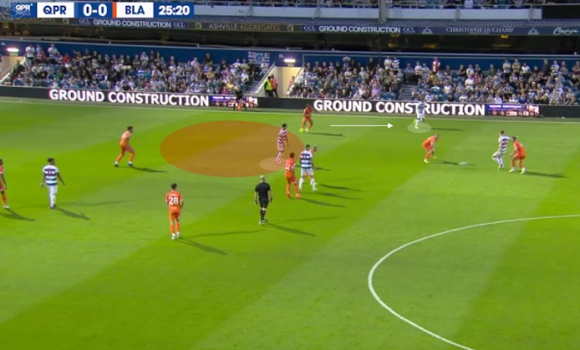
Laird shows tactical intelligence to drop deeper and draw Thompson with him to create even more space. Dickie drives into the space, drawing Blackpool to press and causing Dozzell to be found between the lines creating an opening on the half turn.
Just from this example in one game for Laird it shows his tactical intelligence alongside new signing Tyler Roberts to create positional overloads and even rotations. Beale has said in interviews that some of the attacking identity within this team is through combinations in wide areas, so with the added quality of Laird, the overloads down the right should hopefully be as fluid as Chair and Willock down the left.
In terms of positional overloads, they help us to create attacks mainly in the wide areas by pinning opposition players or through the use of movement. The repetition of the pattern can show how the lack of discipline of one opposition player can have a knock-on effect for the defensive unit or defensive shape out wide, in this instance, to stop the penetration of our attack. We have shown good execution to overload teams numerically or cause problems through positional dilemmas in the opening league games.
So, Rangers have come away with five points from the first five games and there are clear patterns emerging within a Mick Beale side. More emphasis on wide combinations/overloads, defensive rotations, creating overloads in build-up and a more compact and defensive shape as we have looked more secure out of possession compared to last season.
The early signs are promising, and of course there are still teething problems, but with time we might see more patterns emerging or improvements on what’s already occurring.
Links >>> More like this at Dan’s SubStack >>> R Generation interview with Dan and Andre Dozzell
If you enjoy LoftforWords, please consider supporting the site through a subscription to our Patreon or tip us via our PayPal account loftforwords@yahoo.co.uk.
Pictures — QPRPlusPass
The Twitter @DanLambert_
Action Images
Please report offensive, libellous or inappropriate posts by using the links provided.
dutch added 17:58 - Aug 22
That was great. I didn't understand a word of it. |  | |
jackl29 added 18:55 - Aug 22
This is Class, thanks mate! |  | |
knocker added 20:54 - Aug 22
No wonder the players are confused. |  | |
sexton added 21:04 - Aug 22
It's not a simple game then. |  | |
ozexile added 22:25 - Aug 22
Fantastic article thank you. |  | |
Myke added 22:45 - Aug 22
Sincere thanks to Dan and this is by no means aimed at you. However, if the players are actually trying to implement this in a game,then it is no wonder we are struggling, because this is the greatest load of bolox I have ever seen. My estimation of Beale has plummeted. I am now very worried. Football is a SIMPLE, spontaneous, beautiful game.The theory of what you can do in a text book and what happens in reality are miles apart in most walks of life and never more so than in football and thank goodness for that. 'Trigger press' indeed |  | |
Northernr added 23:57 - Aug 22
Myke the only bolox on here is your comment. Not for the first time either. |  | |
QPRski added 06:35 - Aug 23
Thanks for a very detailed and interesting analysis. It is very much appreciated.
I will observe the next games with a new insight and hope that hope it brings the much desired results!
|  | |
bakerloo8 added 08:17 - Aug 23
Wow. Brain melted 🤣
Excellent broken down analysis, I will dip more into depth on this later when I have devoured it.
Nice work 👠| 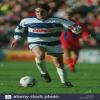 | |
Spanishal added 08:54 - Aug 23
Foot ball chess!! Whatever happened to Football’s a simple game. If the players have to think about this all the time it’s no wonder they can’t put the ball in the back of the net |  | |
TheChef added 08:55 - Aug 23
Space. The final frontier. |  | |
Myke added 09:23 - Aug 23
Just seen this comment Clive - that it, I'm out |  | |
HantsR added 10:00 - Aug 23
Many thanks to Dan Lambert! However, I've just realised how little I know about football, despite having watched it for over half a century. A lot for my poor little brain to absorb and understand but I'll have a go...next time I'm sat in SAR, I'll amaze everyone near me with my shrewd insights into tactics being deployed. |  | |
JPC added 10:10 - Aug 23
Really enjoyed this, and find the negativity strange. It may be new to us in terms of having someone analyse it and break it down, but this has been going on for years. Teams with ‘lesser’ players will always try to negate the other team’s advantage, so the better teams will come up with approaches to overcome this. The chess analogy above is fair. You will still accommodate flair players to make th difference. |  | |
ARudd added 10:12 - Aug 23
And, of course, I know have solid proof I know nothing about football!!
Great article, even if I like many others, understood very little of it!
I'll stick to berating the Assistants running the Ellerslie Road touchline from now on... |  | |
francisbowles added 10:43 - Aug 23
Very interesting piece, thank you Dan. Something I will refer back to, to check understanding and see if I can pick up on some of it from SA Road.
Wanted players, cv must include GCSE Maths with emphasis on Geometry.
. |  | |
FavRangers8 added 10:52 - Aug 23
Thanks for this Dan, we forget that the game is getting quicker and quicker these days that it's sometimes quite tricky to spot these patterns in live action. I think this highlights how some players work can go under-appreciated too.
Really enjoyed this piece and hope to see more analysis pieces in future. |  | |
SimonJames added 13:36 - Aug 23
And I thought explaining rugby moves to people was complicated!
So with all these defensive rotations and positional structures, how do they react to a fast player just running, with the ball, straight at a defender with the intention of simply beating them and then passing? | 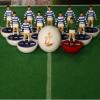 | |
dannyblue added 16:04 - Aug 23
Enjoyable read. Only thing I'd add is I saw the 4321 become a 4312 at times, and in the most recent game (not covered by this?) it was very much a 4231.
It's my impression that in the first games opponents have made easy progress up our flanks as it takes time for the widest midfielder to get out to the ball, and our fullback has held their position. While that's galling to watch, it may be working defensively to some extent as I can't recall goals being conceded from there yet. |  | |
EastR added 14:58 - Aug 24
@dannyblue – Bowler scored against us by attacking in the LB channel then stepping inside and around the midfield cover coming out wide |  | |
SuffolkHoop added 14:58 - Aug 24
This was really interesting. Thanks! |  | |
headhoops added 16:39 - Aug 24
Fascinating and has given me a new perspective on what Beale is trying to acheive. My basic knowledge led me to believe that Dunne and Dickie were trying to establish themselves as the new chuckle brothers. To me to you, to me to you.
Serious question, why do we no longer leave anyone up front when we face a corner? |  | |
You need to login in order to post your comments | 






























